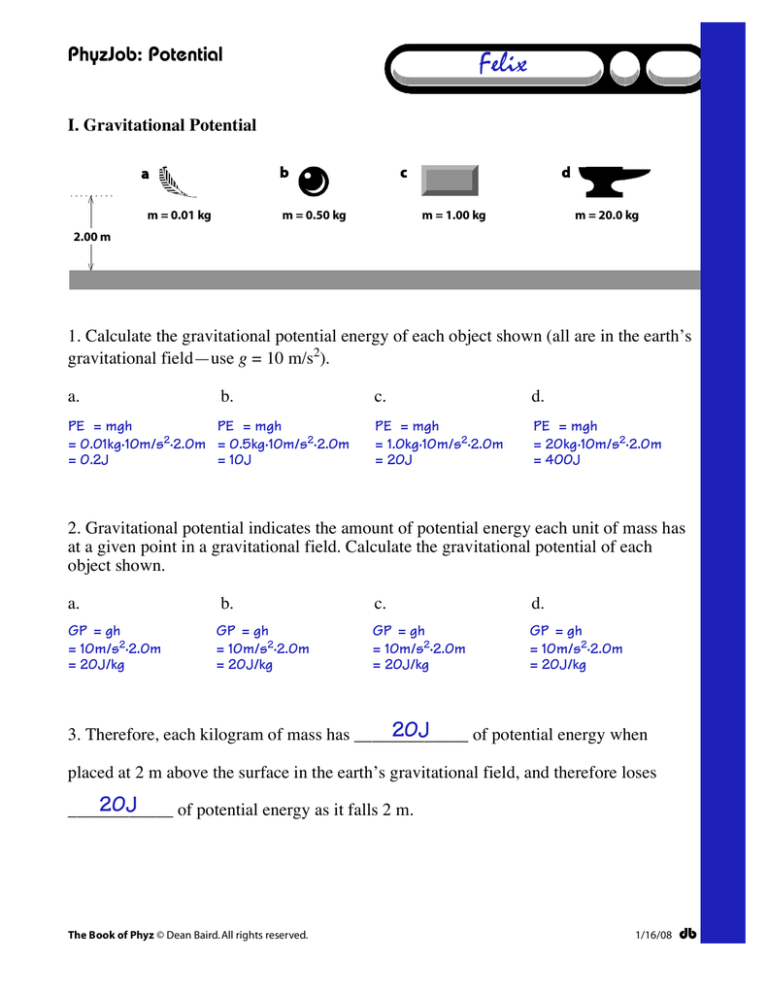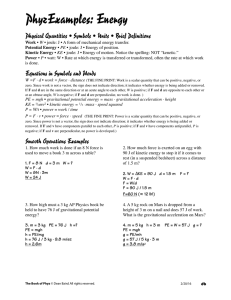
PhyzJob: Potential
Felix
I. Gravitational Potential
b
a
m = 0.01 kg
c
m = 0.50 kg
d
m = 1.00 kg
m = 20.0 kg
2.00 m
1. Calculate the gravitational potential energy of each object shown (all are in the earth’s
gravitational field—use g = 10 m/s2).
a.
b.
PE = mgh
PE = mgh
2
= 0.01kg·10m/s ·2.0m = 0.5kg·10m/s2·2.0m
= 0.2J
= 10J
c.
d.
PE = mgh
= 1.0kg·10m/s2·2.0m
= 20J
PE = mgh
= 20kg·10m/s2·2.0m
= 400J
2. Gravitational potential indicates the amount of potential energy each unit of mass has
at a given point in a gravitational field. Calculate the gravitational potential of each
object shown.
a.
b.
c.
d.
GP = gh
= 10m/s2·2.0m
= 20J/kg
GP = gh
= 10m/s2·2.0m
= 20J/kg
GP = gh
= 10m/s2·2.0m
= 20J/kg
GP = gh
= 10m/s2·2.0m
= 20J/kg
20J
3. Therefore, each kilogram of mass has _____________
of potential energy when
placed at 2 m above the surface in the earth’s gravitational field, and therefore loses
20J
____________
of potential energy as it falls 2 m.
The Book of Phyz © Dean Baird. All rights reserved.
1/16/08
db
II. Electric Potential
+
+
2.00 cm
a
b
c
d
q = 2.00 nC
q = 300 nC
q = 1.00 µC
q = 5.00 mC
–
–
4. Calculate the electric potential energy of each charge shown (all are immersed in a
1,000,000 N/C electric field).
a.
b.
c.
d.
PE = qEd
PE = qEd
= 1x10–6C·1x106N/C·0.02m
= 2x10–9C·1x106N/C·0.02m
= 0.02 J
= 4x10–5 J
PE = qEd
PE = qEd
= 20 mJ
= 40 µJ
–9
6
= 5x10–3C·1x106N/C·0.02m
= 300x10 C·1x10 N/C·0.02m
–3
= 100 J
= 6x10 J
= 6 mJ
5. Electric potential indicates the amount of potential energy each unit of charge has at a
given point in an electric field. Calculate the electric potential of each charge shown.
a.
b.
c.
V = Ed
= 1x106N/C·0.02m
= 20,000 J/C
= 20 kV
V = Ed
= 1x106N/C·0.02m
= 20,000 J/C
= 20 kV
V = Ed
= 1x106N/C·0.02m
= 20,000 J/C
= 20 kV
d.
V = Ed
= 1x106N/C·0.02m
= 20,000 J/C
= 20 kV
20,000 J of potential energy when
6. Therefore, each coulomb of charge has _____________
placed at the positive plate (2 cm from the negative plate), and therefore loses
20,000 J of potential energy as it “falls” across that 2 cm gap.
____________
7. If a single coulomb of charge passes from the + terminal to the – terminal of a 12 V
battery, how much energy does it give up?
12 J
The Book of Phyz © Dean Baird. All rights reserved.
1/16/08
db




